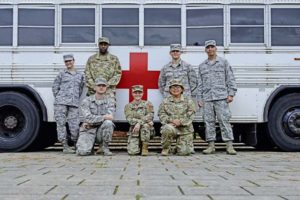
Taking care of Airmen and families is one of the top priorities of the Air Force and its leaders. It’s also a priority that drives much of the daily mission at Ramstein Air Base due to its aeromedical evacuation and en route patient staging capabilities.
“The 54,000 Americans who live and work in the Kaiserslautern Military Community depend on Ramstein every day for support, but our support to warriors and families extends far beyond the local area,” said Scott Lockard, 86th Airlift Wing vice director. “Because of our strategic location, runway, and medical facilities, we’re often the first stop when a wounded service member needs aeromedical evacuation while serving in Europe, Africa or the Middle East.”
Along with its mission partners from the 521st Air Mobility Operations Wing, Ramstein exercises its aeromedical evacuation capability almost daily, and that capability continues, “because of the care and dedication our men and women devote to make the systems work,” Lockard said.
“For me, this job feels much more rewarding because I’m actually helping people that need the help,” said Senior Airman Victoria Richard, 86th Aerospace Medicine Squadron medical technician.
Richard originally worked in Family Medicine but transferred to En-Route Patient Staging, where injured patients begin their medical process after they’re airlifted to the base.
“ERPS is responsible for picking up the patients at the aircraft and moving them to Landstuhl Regional Medical Center, where they get staged and stabilized until they’re ready to be moved back to the United States,” said Lt. Col. (Dr.) Tracy Bozung, 86th AMDS commander.
Ramstein has been a hub for these medical air evacuation procedures for years. It is a capability that saved countless lives during the height of combat operations in Iraq and Afghanistan, and continues to support service members serving in combat zones today.
Four wounded warriors, hosted by the Semper Fi Fund non-profit organization, recently visited Ramstein to give thanks for the care they received here after being wounded in combat years earlier. Like many patients, they were unconscious for most of their transition through ERPS. Seeing the process they went through years later was an emotional experience for some of them.
“One of the wounded warriors was triggered because he remembered the day he was hurt,” said Tech. Sgt. Daryl Agni, 86th ERPS flight chief. Agni said the veteran was in tears when he walked through the different locations where he had received care and met the people who provide critical treatment to service members as they transit home.
“If that happened to me, I’d have the same feelings,” said Agni. “If I were given a second chance at living again, I’d use the opportunity to help other people. I’m always honored to help the wounded veterans that defended our country. They deserve to be recognized as well. They sacrifice their lives for us so why shouldn’t we do the same for them?”
Overall, Ramstein’s aeromedical evacuation and ERPS capabilities support the entire Joint Force, and Airmen assigned here can feel good knowing they are part of a team that directly impacts the lives of warriors and families every day.
“Together, we provide enormous strategic value to the Air Force and the rest of the Joint Force,” said Lockard.


